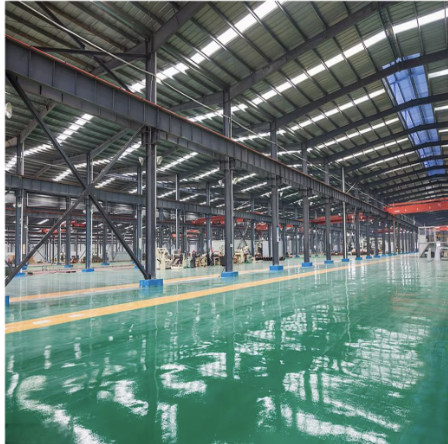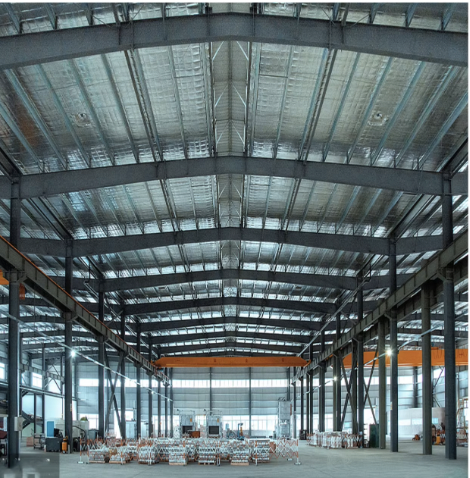Регулярные осмотры стальных конструкций
Виды строительных обследований
Регулярные осмотры необходимы для поддержания целостности стальные конструкции . Существует несколько видов обследований, каждое из которых выполняет уникальную функцию в обеспечении безопасности и долговечности.
- Визуальные осмотры : Это поверхностные проверки, которые выявляют очевидные проблемы, такие как ржавчина, деформация или видимые повреждения. Они важны для раннего обнаружения проблем, которые более детальный осмотр может выявить позже.
- Детальные осмотры : Они включают всестороннюю оценку и могут требовать специализированных инструментов или оборудования. Детальные осмотры помогают выявить потенциальные риски, которые могут привести к структурной неисправности, если их своевременно не устранить.
- Специальные осмотры : Это настроенные осмотры, направленные на конкретные проблемы, например, оценку после стихийных бедствий или целевые оценки в районах, подверженных повторяющимся повреждениям.
Плановые осмотры способствуют соблюдению нормативных стандартов и помогают предотвратить непредвиденные осложнения. Выявляя проблемы на ранней стадии с помощью регулярных проверок, можно избежать дорогостоящего ремонта и обеспечить долговечность стальных конструкций.
Ключевые контрольные точки коррозии
Коррозия является распространенной проблемой для стальных конструкций, особенно в областях, подверженных воздействию влаги или химикатов. Определение ключевых контрольных точек коррозии через регулярные осмотры критически важно для проактивного обслуживания.
- Соединения и швы : В этих местах часто скапливается вода, что приводит к ускоренной коррозии. Регулярные проверки могут помочь выявить первые признаки ржавчины и предотвратить дальнейшее распространение.
- Области, соприкасающиеся с водой : Любая часть конструкции, которая регулярно сталкивается с водой, должна находиться под тщательным контролем. Скорость коррозии может значительно варьироваться; например, данные показывают, что стальные конструкции могут испытывать среднее увеличение скорости коррозии до 20% ежегодно в влажных условиях.
Использование современных методик, таких как ультразвуковое тестирование и визуальный осмотр, повышает способность обнаруживать коррозию, тем самым усиливая меры безопасности при обслуживании стальных конструкций.
Определение признаков усталости соединений
Усталость соединений в стальных конструкциях проявляется различными узнаваемыми формами. Раннее распознавание этих признаков жизненно важно для поддержания целостности конструкции.
- Видимые трещины и смещения : Эти физические изменения указывают на напряжение или повреждение внутри конструкции. Регулярный мониторинг помогает документировать любые изменения со временем, что может направить будущие ремонты.
- Необычные шумы во время работы : Эти шумы могут означать основные проблемы, которые требуют немедленного внимания. Важно быть бдительным на любые изменения, которые могут указывать на усталость суставов.
Эксперты подчеркивают, что окружающие факторы, такие как колебания температуры и воздействие элементов, могут значительно влиять на усталость соединений. Поэтому рекомендуется своевременно проводить осмотры для минимизации потенциальных рисков, связанных с усталостью соединений, обеспечивая безопасность и надежность конструкции со временем.
Методы защиты от коррозии
Гальванизация против покрытий ингибиторов ржавчины
Для защиты стали от коррозии большинство людей обращают внимание на оцинкование или на применение ингибиторов ржавчины. При оцинкованном покрытии стальной поверхности наносится толстый слой цинка, который служит сильным защитным щитом от ржавчины и долговечен. Ингибиторы ржавчины работают по-другому. Они в основном химические вещества, окрашенные или распыляемые на металл, чтобы остановить окисление. Эти подходы сильно различаются по тому, как они применяются и как долго они сохраняются. При очень суровых условиях оцинкованная сталь лучше выдерживает давление, особенно там, где много влаги или соленого воздуха, например, рядом с заводами или прибрежными районами. Преимущество ингибиторов ржавчины в том, что если они начинают отступать, просто наденьте на них другой слой, а не переделывайте весь процесс. Они, как правило, дешевле заранее, поэтому подрядчики, работающие с ограниченным бюджетом, часто идут по этому пути. Однако, если посмотреть на расходы с течением времени, то это говорит о другом. Конечно, вначале оцинкование стоит дороже, но эти дополнительные деньги обычно окупаются за счет снижения расходов на обслуживание. Это делает оцинкование более умным выбором для крупных инфраструктурных проектов, где никто не хочет беспокоиться о починках каждые несколько лет.
Системы мониторинга влажности
Следить за влажностью очень важно, когда речь идет о предотвращении коррозии до ее начала, особенно вокруг стальных конструкций, где контроль влажности имеет наибольшее значение. Эти системы мониторинга в основном следят за тем, что происходит с уровнем влажности воздуха, а затем запускают все необходимые элементы управления, чтобы восстановить равновесие, что помогает остановить образование этих надоедливых пятен ржавчины. Компании, устанавливающие такие системы, как правило, видят реальные выгоды, особенно в местах, где влажность высока круглый год. Возьмем, к примеру, склады или фабрики - простое поддержание влажности на разумном уровне существенно влияет на частоту возникновения проблем с коррозией. Исследования показывают, что когда влажность слишком высока, стальные конструкции начинают проявляться намного быстрее, чем должны. Поэтому вместо того, чтобы ждать, пока произойдут повреждения, умные компании опережают проблему, активно управляя влажностью. Этот подход не только экономит деньги на ремонте, но и позволяет зданиям и оборудованию работать долгие годы.
Быстрое устранение повреждений краски
Быстрое доведение до этих щелей и царапин делает всю разницу, когда дело доходит до предотвращения коррозии стальных конструкций. Без этого защитного покрытия металл под ним быстро начинает подвергаться ржавчине. Позвольте мне поделиться тем, что лучше всего работает по моему опыту: регулярно проверяйте поверхности, чтобы проблемы не оставались незамеченными. Когда что-то выглядит не так, сначала почистите всю грязь, которая там накопилась. Затем наденьте хорошее качество антикоррозионного праймера, прежде чем закончить с соответствующим верхним слоем, который действительно прилипает. Большинство людей, работающих в техническом обслуживании, знают, что это не просто чтобы держать вещи в хорошем состоянии. Правильная краска действует как броня против погоды, которая день за днем обрушивается на конструкции. Почини эти маленькие трещины пока они еще поддаются управлению вместо того, чтобы ждать, пока мы не получим большие дорогие ремонты впереди, потому что кто-то проигнорировал ранние предупреждающие знаки.
Поддержание структурной целостности
Тестирование натяжения болтов
Испытание напряжения болта имеет большое значение, когда дело доходит до сохранения целостности конструкции и избежания развала деталей. Когда болты правильно затягиваются, они соединяют воедино стальные рамки. Если не достаточно крепко, суставы могут скользить и в конечном итоге привести к разрушению целых конструкций. Есть несколько способов проверить это на практике. Механики часто берут ключи от крутящего момента или специальные приборы для измерения напряжения, чтобы получить показания и внести необходимые изменения на месте. Некоторые исследования указывают на то, что около 30% всех обрушений стальных зданий связаны с ненадлежащим затягиванием болтов. Поэтому регулярные проверки с хорошим оборудованием действительно имеют значение, когда вы хотите надежных и безопасных стальных конструкций на разных проектах.
Мониторинг осадки фундамента
Следить за тем, насколько фундамент здания оседает в земле, очень важно, когда речь идет о сохранении стальных конструкций. Когда мы начинаем видеть такие вещи, как трещины в стенах или полах, которые наклоняются вместо того, чтобы быть плоскими, это красные флаги, указывающие на более серьезные проблемы в будущем. Есть несколько способов, которыми профессионалы проверяют это - некоторые старые инструменты выравнивания по-прежнему отлично работают наряду с современными приборами измерения расселения, которые фактически записывают точки данных по мере прохождения месяцев. Большинство инженеров расскажут любому, кто слушает, о том, как зафиксировать проблемы раньше, чем они станут дорогими. Подумайте о правильном укреплении основания или, возможно, даже о введении стабилизаторов в нестабильные почвы вокруг основания. Это не просто теоретические решения; многие строительные площадки избавились от серьезных головных болей, просто регулярно отслеживая небольшие движения в их фундаменте. Однако суть остается довольно простой: регулярные проверки означают более безопасные здания, стоящие на вершине на десятилетия, а не разрушающиеся неожиданно.
Усиление против ветровой нагрузки
Если хорошо понять, как ветер влияет на здания, то это будет иметь решающее значение для укрепления стальных конструкций, особенно в случае сильных штормов. Сильные ветры сильно напрягают здания и могут привести к их изгибу, изгибу или даже обрушению без надлежащих подпорных систем. Инженеры обычно полагаются на такие вещи, как диагональные опоры и дополнительные опоры, чтобы противостоять этим мощным силам. Следование установленным строительным правилам и передовым практикам по устойчивости ветрам помогает обеспечить прочность конструкций при экстремальных погодных условиях. Когда строители используют эти методы усиления, они не только защищают саму физическую конструкцию, но и гарантируют безопасность жителей, и здание прослужит намного дольше, несмотря на годы воздействия суровых погодных условий.
Смазка механических компонентов
Техническое обслуживание секционных ворот
Если держать роликовые двери в хорошем состоянии, то они будут работать лучше. Главное внимание следует уделять смазке движущихся деталей, проверке их подвижности и тщательному изучению компонентов во время рутинных проверок. Когда правильно смазывают, меньше трения при работе. Хорошее выравнивание означает, что дверь будет двигаться гладко, не застряв. Регулярные визуальные осмотры помогают выявить проблемы, прежде чем они станут серьезными головными болями. Большинство специалистов рекомендуют составлять план обслуживания, включающий ежемесячные сеансы смазки и полные осмотры раз в год. Если посмотреть на информацию о гарантии от производителей, то можно увидеть что-то интересное: те, кто придерживается регулярных графиков обслуживания, имеют меньше сбоев и гораздо более долгий срок службы, чем те, кто инвестировал в роликовые двери.
Графики смазки петель
Регулярное обслуживание с надлежащей смазкой помогает сохранить работоспособность петлей без чрезмерного износа. Когда петли начинают издавать эти раздражающие звуки или чувствуют себя жесткими, это по сути способ природы сказать, что им нужна любовь. Любой, кто имел дело с скрипящими дверями, точно знает, о чем я. Обратите пристальное внимание на любые странные скрипки или мельчание звуки, исходящие от петлей во время нормальной работы это явные предупреждающие знаки, что смазка должна произойти в ближайшее время. Для достижения наилучших результатов используйте качественную смазку, которая не будет коррозировать материал, из которого сделан шарнир. В конце концов, разные материалы требуют разной обработки. Использование правильного изделия не только позволяет улучшать работу устройства, но и увеличивает срок службы этих петлей, прежде чем их нужно будет заменить.
Предотвращение износа металла о металл
Когда металлические части трются друг с другом без достаточной смазки, это создает то, что инженеры называют металлическим износ. Это происходит, когда две поверхности вступают в прямой контакт, вызывая трение, которое с течением времени изнашивает их, пока они не потерпят неисправность. Согласно различным отчетам о машиностроении, если вещь правильно смазывать, то уменьшается количество повреждений. Машины лучше работают в течение длительного времени, когда мы регулярно заботимся о потребностях смазки. Для тех, кто хочет, чтобы его машины работали гладко, имеет смысл развивать хорошие привычки обслуживания. Разные машины нуждаются в различных типах смазочных материалов, применяемых определенным образом, поэтому понимание того, что лучше всего работает для конкретного оборудования, очень важно для предотвращения этих дорогостоящих сбоев в дальнейшем.
Протоколы Профессиональной Оценки
Критерии Сертифицированного Инспектора
Знание того, что делает человека хорошим инспектором, имеет большое значение, когда дело доходит до правильного проведения надежных структурных оценок. Инспекторы, которые имеют соответствующую сертификацию, обычно приносят несколько важных вещей на стол, включая надлежащие полномочия, многолетний опыт работы, а также глубокое понимание работы зданий. Когда эти элементы соединяются во время проверки, проблемы обнаруживаются до того, как они превратятся в катастрофу, что означает меньше сюрпризов на дороге. Подрядчики и владельцы зданий видят реальную ценность в найме сертифицированных людей, потому что весь процесс оценки становится намного более надежным, и стандарты безопасности остаются там, где они должны быть. Исследования, проведенные в различных отраслях, постоянно указывают на лучшие результаты безопасности, когда сертифицированные специалисты занимаются проверками. Эти профессионалы точно знают, где искать слабые места в стальных конструкциях, часто обнаруживая проблемы задолго до того, как кто-то другой заметит их. Отчеты отрасли подтверждают это, показывая явные улучшения показателей безопасности после проведения регулярных сертифицированных проверок, что каждый управляющий недвижимостью знает, что это просто здравый смысл в современном мире.

Методы неразрушающего контроля
Когда дело доходит до проверки стальных конструкций, неразрушительные методы испытаний, такие как ультразвуковое и радиографическое испытание, играют очень важную роль. Эти методы позволяют инженерам заглянуть внутрь металлических компонентов, не повреждая их. Эти тесты настолько ценны, что они позволяют выявить, что происходит под поверхностью материалов, давая техникам подробную информацию о потенциальных проблемах, прежде чем они станут серьезными. Преимущества тоже очевидны. Точные оценки помогают сохранить стандарты безопасности на уровне, а также увеличивают срок службы этих конструкций до необходимости их замены. Приложения в реальном мире поддерживают это в различных отраслях. Например, многие мосты и промышленные объекты в значительной степени зависят от регулярных НДТ-проверк, чтобы обнаружить крошечные трещины или слабости, которые невозможно было бы увидеть невооруженным глазом. Включая эти методы тестирования в график регулярного обслуживания, компании в долгосрочной перспективе экономили деньги, избегая дорогостоящих аварийных ремонтов и гарантируя, что их инфраструктура останется безопасной и функциональной в течение многих лет.
Документация записей технического обслуживания
Хорошая документация о проверках и техническом обслуживании очень важна как для повседневного обслуживания конструкции, так и для долгосрочного планирования. Когда компании имеют подробные записи о том, что было сделано, когда и кем, они остаются в соответствии со всеми этими надоедливыми юридическими требованиями, принимая лучшие решения о решении проблем или модернизации систем. Большинство специалистов согласны с тем, что наличие какой-то организованной системы отслеживания технического обслуживания облегчает жизнь в будущем. Если все будет правильно задокументировано, то каждый сможет точно увидеть, какие ремонты были сделаны ранее, и точно внести коррективы, если что-то пойдет не так позже. Эти записи становятся золотыми рудниками информации, когда пытаются сохранить стальные конструкции в соответствии с отраслевыми стандартами. Они также показывают закономерности со временем, помогая менеджерам выявлять повторяющиеся проблемы, прежде чем они превратятся в большие головные боли. Компании, которые серьезно относятся к своей документации, как правило, работают более гладко, потому что все знают, что было сделано и что еще требует внимания.
Часто задаваемые вопросы
Почему регулярные осмотры важны для стальных конструкций?
Регулярные осмотры критически важны, так как они помогают поддерживать конструкционную целостность, обеспечивать безопасность и предотвращать дорогие ремонты за счет выявления проблем на ранней стадии.
Какие существуют распространенные методы защиты от коррозии для стальных конструкций?
Распространенные методы включают оцинковку и покрытия ингибиторами ржавчины, которые защищают стальные конструкции от окисления и ржавчины.
Как проверка натяжения болтов способствует сохранению конструкционной целостности?
Проверка натяжения болтов гарантирует, что соединения устойчивы, помогая предотвратить смещение соединений и потенциальные конструкционные неудачи.
Какую роль играют сертифицированные инспекторы в поддержании строительных конструкций?
Сертифицированные инспекторы проводят надежные оценки стальных конструкций, выявляя уязвимости и обеспечивая соблюдение стандартов безопасности.
Содержание
- Регулярные осмотры стальных конструкций
- Методы защиты от коррозии
- Поддержание структурной целостности
- Смазка механических компонентов
- Протоколы Профессиональной Оценки
-
Часто задаваемые вопросы
- Почему регулярные осмотры важны для стальных конструкций?
- Какие существуют распространенные методы защиты от коррозии для стальных конструкций?
- Как проверка натяжения болтов способствует сохранению конструкционной целостности?
- Какую роль играют сертифицированные инспекторы в поддержании строительных конструкций?






